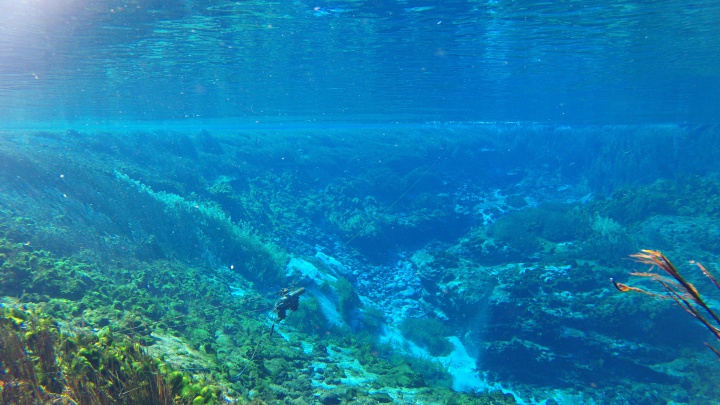Footage shows exceptional clarity of Te Waikoropupū Springs
FRIDAY, MAY 25, 2018
Underwater footage shows exceptional clarity of Te Waikoropupū Springs

On the bottom of
New Zealand’s largest freshwater springs is an underwater
garden of vivid green, pinks and inky blues.
The
water of Te Waikoropupū Springs, near Takaka, is so clear
it is a vivid blue colour, adding an extra vibrancy to the
plants growing there. Recently NIWA finished a three-month
monitoring project at the springs measuring the clarity of
the water for Tasman District Council (TDC).
NIWA scientist Mark Gall used a GoPro camera to film the deployment of the monitoring instruments and to check they were in the right place.
The underwater footage he captured also provided him with some insight into how the springs work, and how the water clarity varies for short periods when water pushes out through layers of sand.
NIWA estimates the visual clarity of the springs to be about 76m, although at times it approached 81m which is just short of the theoretical maximum of pure water at about 83m. This is similar to the globally renowned Blue Lake in Nelson Lakes National Park.
The last time water clarity measurements were made at Te Waikoropupū was in 1993 by the Department of Scientific and Industrial Research. At that time the visual clarity was measured by divers at 63m.
Since then, technology has advanced, theoretical maximum clarity measurements have been revised and divers are no longer permitted in the spring.
So NIWA used measuring instruments hung from a submerged line near one of the main vents. This novel deployment method, similar to a zip line, was used to position the instruments with the line then lowered into place below the surface. The main instrument used is a beam transmissometer which captured 60 readings in one-minute bursts, every 10 minutes, resulting in nearly a million water clarity estimates over the deployment period.
This provided a comprehensive data set to assess how visual clarity in the springs varies over different time scales, from minutes to months.
“What this study shows us is that the Te Waikoropupū Springs have exceptional visual clarity, at times close to that of pure water, and broadly comparable to that of Blue Lake which has a visual clarity of 70-80m,” Mr Gall said.
The high frequency monitoring detected small daily variations corresponding to about 1-2m in visual clarity, with the highest visibility at midnight, and lowest around midday.
“This is
likely to be due to plants in the spring basin releasing
light-scattering oxygen bubbles as they photosynthesize
during the day”, Mr Gall said.
Underwater video
demonstrated that “dancing”’ white marble sands on the
floor of the springs coincided with some short-term episodes
of reduced visual clarity, lasting between a few hours and
several days.
The exceptional visual clarity appears to result from extremely efficient natural filtering removing particles within the springs aquifer before re-emergence of the water. Te Waikoropupū Springs, along with Blue Lake, are considered to have some of the clearest waters ever measured. Te Waikoropupū are also the largest cold water springs in the Southern Hemisphere.
Maintaining the existing clarity of Te Waikoropupū is a key priority identified through TDC’s collaborative planning process with the Takaka community under the National Policy Statement for Freshwater Management.
ends


 Business Canterbury: Urges Council To Cut Costs, Not Ambition For City
Business Canterbury: Urges Council To Cut Costs, Not Ambition For City Wellington Airport: On Track For Net Zero Emissions By 2028
Wellington Airport: On Track For Net Zero Emissions By 2028 Landcare Research: ANZAC Gall Fly Release Promises Natural Solution To Weed Threat
Landcare Research: ANZAC Gall Fly Release Promises Natural Solution To Weed Threat NZ Anti-Vivisection Society: Auckland Rat Lovers Unite!
NZ Anti-Vivisection Society: Auckland Rat Lovers Unite! University of Canterbury: $1.35 Million Grant To Study Lion-like Jumping Spiders
University of Canterbury: $1.35 Million Grant To Study Lion-like Jumping Spiders Federated Farmers: Government Ends War On Farming
Federated Farmers: Government Ends War On Farming



